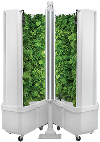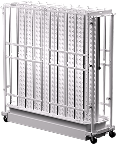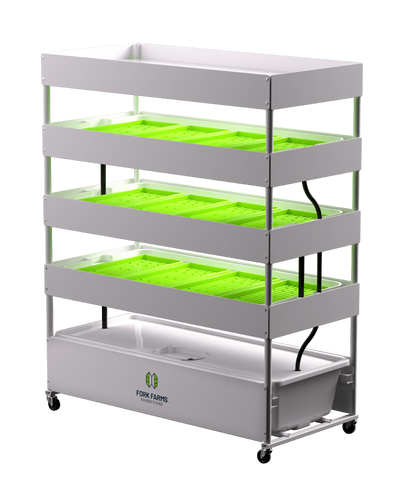Can You Grow Tomatoes Indoors? A Guide To Growing Tomatoes Indoors Using A Hydroponic Garden
Whether you consider them fruits or vegetables, tomatoes are without a doubt one of our most versatile foods. They’re at home in everything from fresh salads and salsas to soups, sauces, and your favorite BLT.
But depending on where you live, it may not be possible to get plump, juicy, locally sourced tomatoes anytime you want. That is, unless you grow them hydroponically.
An Overview of Hydroponics
Hydroponic gardening is the practice of growing plants using water and nutrient-rich solutions instead of soil. This type of gardening allows people to grow plants in a controlled environment, often indoors. In place of soil, hydroponic systems use a medium like rockwool, coconut fibers, perlite, or clay pellets to anchor the plants.
These gardens can be set up almost anywhere, from decks and balconies to classrooms and even vacant storefronts. Many are also scalable, with the smallest units requiring only a few feet of growing space, and the largest covering several hundred. Some of the best systems are configured vertically, further maximizing the available space.
What Are the Benefits of Growing Tomatoes Hydroponically?
Growing tomatoes hydroponically comes with a number of advantages over soil-based methods, starting with the ability to harvest year-round. This simply isn’t possible with traditional soil gardening, mainly because of seasonality. Tomatoes are sensitive to wind, humidity and sunlight, among other elements, and even the most temperate climates can experience unexpected weather swings.
Hydroponic tomatoes often grow faster, too–between 30-50% quicker than their soil-grown counterparts–because they’re given direct access to water and nutrients, and raised in optimal conditions. As a result, some tomato varieties will be ready to harvest within 60 days of planting, if not sooner.
These same factors (a closely managed environment and streamlined nutrient delivery) also produce higher yields and healthier tomatoes, with improved nutritional quality, color, and firmness. Plus, because there’s no soil, hydroponic systems aren’t susceptible to the various pests, pathogens, and diseases that can ravage traditional gardens.
Choosing a Setup For Your Hydroponic Garden To Grow Tomatoes
There are several different types of hydroponic systems that can be used for growing tomatoes. Each has its benefits, and selection should be based on the grower’s available space and budget, as well as personal preference. That said, let’s explore some of the options that generally work best with tomatoes.
Drip Irrigation: This system sends nutrient-rich water directly to the plant’s root zone through the use of tubes and emitters. Because the Drip method offers precise control over watering and nutrient delivery–providing a constant supply of both–it’s often the go-to setup for tomato growers.
Nutrient Film Technique (NFT): NFT systems release a thin film of solution that flows over the plants’ roots, giving them a constant supply of water and nutrients, as well as ready access to oxygen, helping stimulate growth. Also known for its water efficiency, NFT is another popular choice for tomato farmers.
Ebb and Flow System: This type of system floods the root zone with a nutrient-rich solution, which is then drained back into a reservoir. It’s designed to strengthen root development by providing plants with water, nutrients, and oxygen through this cycle of flooding and draining. Ebb and Flow is a versatile configuration that can accommodate plants of varying sizes, including tomatoes.
One system that combines two of the best methods for tomato cultivation is the Flex Farm. Utilizing elements of NFT and Drip, the Flex Farm takes less than an hour to set up, is scalable, and comes with a fully self-contained water system, as well as an energy-efficient LED light tower, submersible pump, Grower Toolkit, and Starter Supplies Box.
Choosing What Tomatoes To Grow In Your Hydroponic Garden
With thousands of different tomato varieties to choose from, selecting which one(s) you want to grow can be overwhelming, especially without some direction. Let’s simplify things by zeroing in on a few key factors to consider in the selection process.
Determinate vs. Indeterminate
Tomatoes generally fall into one of two main categories: determinate and indeterminate. The determinate variety grows outward, like a bush, and produces fruits all at once. By contrast, indeterminates grow on a vine and produce fruits continuously throughout the season. While both types can be grown hydroponically, determinates tend to do better in tighter spaces. This means if you’re growing indoors, or available square footage is limited, these may be the better bet.
Size and Taste of The Tomatoes For Your Hydroponic Garden
When choosing tomato varieties for hydroponic growing, it's important to consider size. Some types produce small cherry tomatoes, while others produce larger beefsteak or heirloom tomatoes. We recommend selecting varieties that match your preferences and how you plan to use the tomatoes–e.g., for snacking, adding to salads, or cooking.
Speaking of which, think about the flavor and texture of your tomatoes. Do you prefer them sweet and tangy, or more acidic? Some tomatoes are very firm to the touch, while others are a bit softer and juicier. Again, much of this boils down to individual taste and the types of dishes you’ll be making.
Good Tomato Growers
Due to the sheer number of tomato varieties–there’s actually about 10,000–it can be tough to pinpoint the “best” ones for hydroponic gardening. However, certain types tend to do particularly well in a controlled indoor environment. They include:
- Cherry tomatoes (Gardener’s Delight, Sun Gold, Sweet Million, Red Robin)
- Heirloom tomatoes (Brandywine, Cherokee Purple, Black Krim)
- Grape tomatoes (Red Grape, Juliet, Tami G)
Care & Maintenance of Your Hydroponic Tomatoes
While our all-in-one solution, the Flex Farm, requires minimal monthly maintenance during grow cycles, there are some factors that any hydroponic tomato farmer should take into account.
All tomatoes need light to grow, and their recommended exposure is about 14-18 hours per day. So regardless of the system you use, grow lights will be an important part of the equation. Keep in mind, too, that lighting requirements vary by plant type.
In terms of their ideal conditions, hydroponic tomatoes grow best in moderate climates. Ideally, humidity should be kept under 40-50%, with temperatures between 65-75°F.
Like many indoor crops, tomatoes also benefit from steady air circulation, which helps strengthen their stems and reduces the risk of fungal diseases. It’s equally important to keep your growing area well-ventilated, as stagnant air can raise humidity levels, which may cause mold to form.
The nutrient solution in hydroponic systems supplies your plants with the minerals they need to grow; in hydroponics, these nutrients are dissolved directly in the water, as opposed to getting absorbed through the soil. For tomatoes, a complete hydroponic nutrient solution should include primary nutrients (Nitrogen, Phosphorus, and Potassium) as well as secondary nutrients (Calcium, Magnesium, and Sulfur) and trace elements (Iron, Manganese, Zinc, Copper, Molybdenum, Boron). Fork Farms sells a nutrient solution that helps better grow quality leafy greens in the Flex Farm.
You'll need to closely monitor pH levels, too. Tomatoes grow best when levels are between 5.5 and 6.5; if you’re out of range, that will likely impact your plants’ ability to absorb the most nutrients. It’s recommended to check pH daily and adjust with pH up or down solutions as needed.
Reap the Rewards
Growing tomatoes hydroponically is a great way to produce a consistent, bountiful harvest year-round, regardless of your location or the conditions outside.
The more you know about the systems, plants, and care required for a thriving tomato crop, the better equipped you’ll be to streamline the cultivation process–and the sooner you’ll be enjoying a plentiful supply of delicious heirlooms, beefsteaks, or whichever variety you choose!
If you’re ready to get started on the path to your own tomato harvest–utilizing Fork Farms’ best-in-class hydroponic technology–we invite you to connect with one of our team members today.
Important Links:
























